The Effects on Stability and Electronic Structure of Si-Segregated θ′/Al Interface Systems in Al-Cu Alloys
Abstract
:1. Introduction
2. Methods and Calculation Models
2.1. Calculation Details
2.2. Interface Properties
2.2.1. Pure Interface Models
2.2.2. Pure Interface Adhesion
2.2.3. Interface Energy
2.2.4. Segregation Energy
3. Results and Discussion
3.1. Interface Adhesion
3.2. Segregation Energy
3.3. Electronic Structure
4. Conclusions
- Si segregation has a significant impact on the θ′/Al semi-coherent and coherent interface energy and bond strength. It can reduce the total energy, increase the interface adhesion, improve the stability of interface systems, and reduce the coarsening drive of the θ′ precipitation phase.
- Si segregation can significantly enhance the bond strength of the θ′/Al interface systems. It promotes the hybridization of Al-Al and Al-Cu orbitals, resulting in enhanced hybridization between them, which is the essential reason for enhancing interface bonding strength.
- Si atoms exhibit a greater tendency to segregate at the Al-slab compared to the θ′-slab, and semi-coherent interface systems with Si at the A1 site have the highest work of adhesion, the most negative segregation energy, and stronger bonding strength.
Author Contributions
Funding
Institutional Review Board Statement
Informed Consent Statement
Data Availability Statement
Conflicts of Interest
References
- Esteban-Manzanares, G.; Martínez, E.; Segurado, J.; Capolungo, L.; LLorca, J. An atomistic investigation of the interaction of dislocations with guinier-preston zones in Al-Cu alloys. Acta Mater. 2019, 162, 189–201. [Google Scholar] [CrossRef]
- Yang, H.; Tian, S.; Gao, T.; Nie, J.; You, Z.; Liu, G.; Wang, H.; Liu, X. High-temperature mechanical properties of 2024 Al matrix nanocomposite reinforced by TiC network architecture. Mater. Sci. Eng. A 2019, 763, 138121. [Google Scholar] [CrossRef]
- Sun, D.; Wang, Y.; Lu, Y.; Chen, Z.; Rao, Q. Influence of atom termination and stacking sequence on the θ′/Al interfaces from first-principles calculations. Superlattices Microstruct. 2016, 94, 215–222. [Google Scholar] [CrossRef]
- Saurabh, G.; Jayaganthan, R.; Joe, A. Laser powder bed fusion on Ti modified Al 2024 alloy: Influence of build orientation and T6 treatment on mechanical behaviour, microstructural features and strengthening mechanisms. Mater. Sci. Eng. A 2024, 896, 146296. [Google Scholar]
- Bahramyan, M.; Mousavian, R.T.; Brabazon, D. Molecular dynamic simulation of edge dislocation-void interaction in pure Al and Al-Mg alloy. Mater. Sci. Eng. A 2016, 674, 82–90. [Google Scholar] [CrossRef]
- Liu, L.; Chen, J.H.; Wang, S.B.; Liu, C.H.; Yang, S.S.; Wu, C.L. The effect of Si on precipitation in Al–Cu–Mg alloy with a high Cu/Mg ratio. Mater. Sci. Eng. A 2014, 606, 187–195. [Google Scholar] [CrossRef]
- Wang, S.; Zhang, C.; Li, X.; Wang, J. Uncovering the influence of Cu on the thickening and strength of the δ′/θ′/δ′ nano-composite precipitate in Al–Cu–Li alloys. J. Mater. Sci. 2021, 56, 10092–10107. [Google Scholar] [CrossRef]
- Poplawsky, J.D.; Michi, R.A.; Allard, L.F.; Bahl, S.; Plotkowski, A.J.; Shyam, A. Using θ′ interfaces as templates for planar L12 precipitation in AlCuMnZr alloys. Addit. Manuf. Lett. 2022, 3, 100086. [Google Scholar] [CrossRef]
- Li, C.; Guo, R.; He, S.; Xuan, W.; Li, X.; Zhong, Y.; Ren, Z. Formation of novel microstructures in quenched Al Cu alloys in steady magnetic field. J. Alloys Compd. 2019, 776, 353–356. [Google Scholar] [CrossRef]
- Wang, L.; Lu, W.; Hu, Q.; Xia, M.; Wang, Y.; Li, J.G. Interfacial tuning for the nucleation of liquid AlCu alloy. Acta Mater. 2017, 139, 75–85. [Google Scholar] [CrossRef]
- Li, Q.; Zhang, Y.; Lan, Y.; Zhang, Y.; Xia, T. The effect of Sc addition on the novel nano-AlCu phase in as-cast Al-5%Cu alloy. J. Alloys Compd. 2020, 831, 154739. [Google Scholar] [CrossRef]
- Xiao, Q.; Liu, H.; Yi, D.; Yin, D.; Chen, Y.; Zhang, Y.; Wang, B. Effect of Cu content on precipitation and age-hardening behavior in Al-Mg-Si-xCu alloys. J. Alloys Compd. 2017, 695, 1005–1013. [Google Scholar] [CrossRef]
- Liang, S.S.; Ma, J.R.; Guo, K.H.; Wen, S.P.; Wei, W.; Wu, X.L.; Huang, H.; Gao, K.Y.; Liu, B.S.; Xiong, X.Y.; et al. Effect of Er and Si co-microalloying on mechanical properties and microstructures of AlCuMg alloys. J. Mater. Res. Technol. 2023, 24, 430–439. [Google Scholar] [CrossRef]
- Liang, S.S.; Wei, W.; Wen, S.P.; Yuan, X.M.; Wu, X.L.; Huang, H.; Gao, K.Y.; Nie, Z.R. Enhanced thermal-stability of AlCuMg alloy by multiple microalloying segregation of Mg/Si/Sc solute. Mater. Sci. Eng. A 2022, 831, 142235. [Google Scholar] [CrossRef]
- Marat, G.; Daniel, M.C.; Jesper, F.; Sigurd, W.; Randi, H.; Rustam, K. Precipitation behavior in an Al–Cu–Mg–Si alloy during ageing. Mater. Sci. Eng. A 2019, 767, 138369. [Google Scholar]
- Li, J.; Chen, S.; Li, F.; Chen, K.; Huang, L. Synergy effect of Si addition and pre-straining on microstructure and properties of Al–Cu–Mg alloys with a medium Cu/Mg ratio. Mater. Sci. Eng. A 2019, 767, 138429. [Google Scholar] [CrossRef]
- Patrick, S.; Jonathan, P.; Sumit, B.; Amit, S. The role of Si in determining the stability of the θ′ precipitate in Al-Cu-Mn-Zr alloys. J. Alloys Compd. 2021, 862, 158152. [Google Scholar]
- Wolverton, C. Crystal structure and stability of complex precipitate phases in Al–Cu–Mg–(Si) and Al–Zn–Mg alloys. Acta Mater. 2001, 49, 3129–3142. [Google Scholar] [CrossRef]
- Ringer, S.P.; Hono, K. Microstructural Evolution and Age Hardening in Aluminium Alloys: Atom Probe Field-Ion Microscopy and Transmission Electron Microscopy Studies. Mater. Charact. 2000, 44, 101–131. [Google Scholar] [CrossRef]
- Liang, S.S.; Wen, S.P.; Wu, X.L.; Huang, H.; Gao, K.Y.; Nie, Z.R. The synergetic effect of Si and Sc on the thermal stability of the precipitates in AlCuMg alloy. Mater. Sci. Eng. A 2020, 783, 139319. [Google Scholar] [CrossRef]
- Booth-Morrison, C.; Seidman, D.N.; Dunand, D.C. Effect of Er additions on ambient and high-temperature strength of precipitation-strengthened Al–Zr–Sc–Si alloys. Acta Mater. 2012, 60, 3643–3654. [Google Scholar] [CrossRef]
- Yang, S.L.; Zhao, X.J.; Chen, H.W.; Wilson, N.; Nie, J.F. Atomic structure and evolution of a precursor phase of Ω precipitate in an Al-Cu-Mg-Ag alloy. Acta Mater. 2022, 225, 117538. [Google Scholar] [CrossRef]
- Hu, S.Y.; Baskes, M.I.; Stan, M.; Chen, L.Q. Atomistic calculations of interfacial energies, nucleus shape and size of θ′ precipitates in Al–Cu alloys. Acta Mater. 2006, 54, 4699–4707. [Google Scholar] [CrossRef]
- Shin, D.; Shyam, A.; Lee, S.; Yamamoto, Y.; Haynes, J.A. Solute segregation at the Al/θ′-Al2Cu interface in Al-Cu alloys. Acta Mater. 2017, 141, 327–340. [Google Scholar] [CrossRef]
- Petrik, M.V.; Gornostyrev, Y.N.; Korzhavyi, P.A. Segregation of alloying elements to stabilize θ′ phase interfaces in Al-Cu based alloys. Scr. Mater. 2021, 202, 114006. [Google Scholar] [CrossRef]
- Chen, H.; Yang, L.; Long, J. First-principles investigation of the elastic, Vickers hardness and thermodynamic properties of Al–Cu intermetallic compounds. Superlattices Microstruct. 2015, 79, 156–165. [Google Scholar] [CrossRef]
- Wang, G.; Peng, L.; Li, K.; Zhu, L.; Zhou, J.; Miao, N.; Sun, Z. ALKEMIE: An intelligent computational platform for accelerating materials discovery and design. Comput. Mater. Sci. 2021, 186, 110064. [Google Scholar] [CrossRef]
- Chong, X.; Hu, M.; Wu, P.; Shan, Q.; Jiang, Y.H.; Li, Z.L.; Feng, J. Tailoring the anisotropic mechanical properties of hexagonal M7X3 (M=Fe, Cr, W, Mo; X=C, B) by multialloying. Acta Mater. 2019, 169, 193–208. [Google Scholar] [CrossRef]
- Zhang, D.L.; Wang, J.; Kong, Y.; Zou, Y.; Du, Y. First-principles investigation on stability and electronic structure of Sc-doped θ′/Al interface in Al−Cu alloys. Trans. Nonferrous Met. Soc. China 2021, 31, 3342–3355. [Google Scholar] [CrossRef]
- Liu, L.H.; Chen, J.H.; Fan, T.W.; Liu, Z.R.; Zhang, Y.; Yuan, D.W. The possibilities to lower the stacking fault energies of aluminum materials investigated by first-principles energy calculations. Comput. Mater. Sci. 2015, 108, 136–146. [Google Scholar] [CrossRef]
- Sheraz, A.; Sidra, B.S.; Muhammad, I.; Muhammad, A.; Kashif, K.M.; Jaehoon, K. Synthesis of long-chain paraffins over bimetallic Na–Fe0.9Mg0.1Ox by direct CO2 hydrogenation. Top. Catal. 2024, 67, 363–376. [Google Scholar]
- Sheraz, A.; Muhammad, I.; Wonjoong, Y.; Neha, K.; Rohmat, S.J.; Kashif, K.M.; Ki, K.S.; Jaehoon, K. Evaluation of MgO as a promoter for the hydrogenation of CO2 to long-chain hydrocarbons over Fe-based catalysts. Appl. Catal. B Environ. 2023, 338, 123052. [Google Scholar]
- Liu, L.M.; Wang, S.Q.; Ye, H.Q. First-principles study of polar Al/TiN(1 1 1) interfaces. Acta Mater. 2004, 52, 3681–3688. [Google Scholar] [CrossRef]
- Siegel Donald, J.; Hector Louis, G.; Adams James, B. First-principles study of metal–carbide/nitride adhesion: Al/VC vs. Al/VN. Acta Mater. 2002, 50, 619–631. [Google Scholar] [CrossRef]
- Li, R.; Chen, Q.; Ouyang, L.; Ding, Y. Adhesion strength and bonding mechanism of γ-Fe (111)/α-Al2O3 (0001) interfaces with different terminations. J. Alloys Compd. 2021, 870, 159529. [Google Scholar] [CrossRef]
- Aaronson, H.I.; Clark, J.B.; Laird, C. Interfacial energy of dislocation and of coherent interphase boundaries. Met. Sci. J. 1968, 2, 155–158. [Google Scholar] [CrossRef]
- Gao, Y.H.; Guan, P.F.; Su, R.; Chen, H.W.; Yang, C.; He, C.; Cao, L.F.; Song, H.; Zhang, J.Y.; Zhang, X.F.; et al. Segregation-sandwiched stable interface suffocates nanoprecipitate coarsening to elevate creep resistance. Mater. Res. Lett. 2020, 8, 446–453. [Google Scholar] [CrossRef]
- Bourgeois, L.; Dwyer, C.; Weyland, M.; Nie, J.F.; Muddle, B.C. Structure and energetics of the coherent interface between the θ′ precipitate phase and aluminium in Al–Cu. Acta Mater. 2011, 59, 7043–7050. [Google Scholar] [CrossRef]
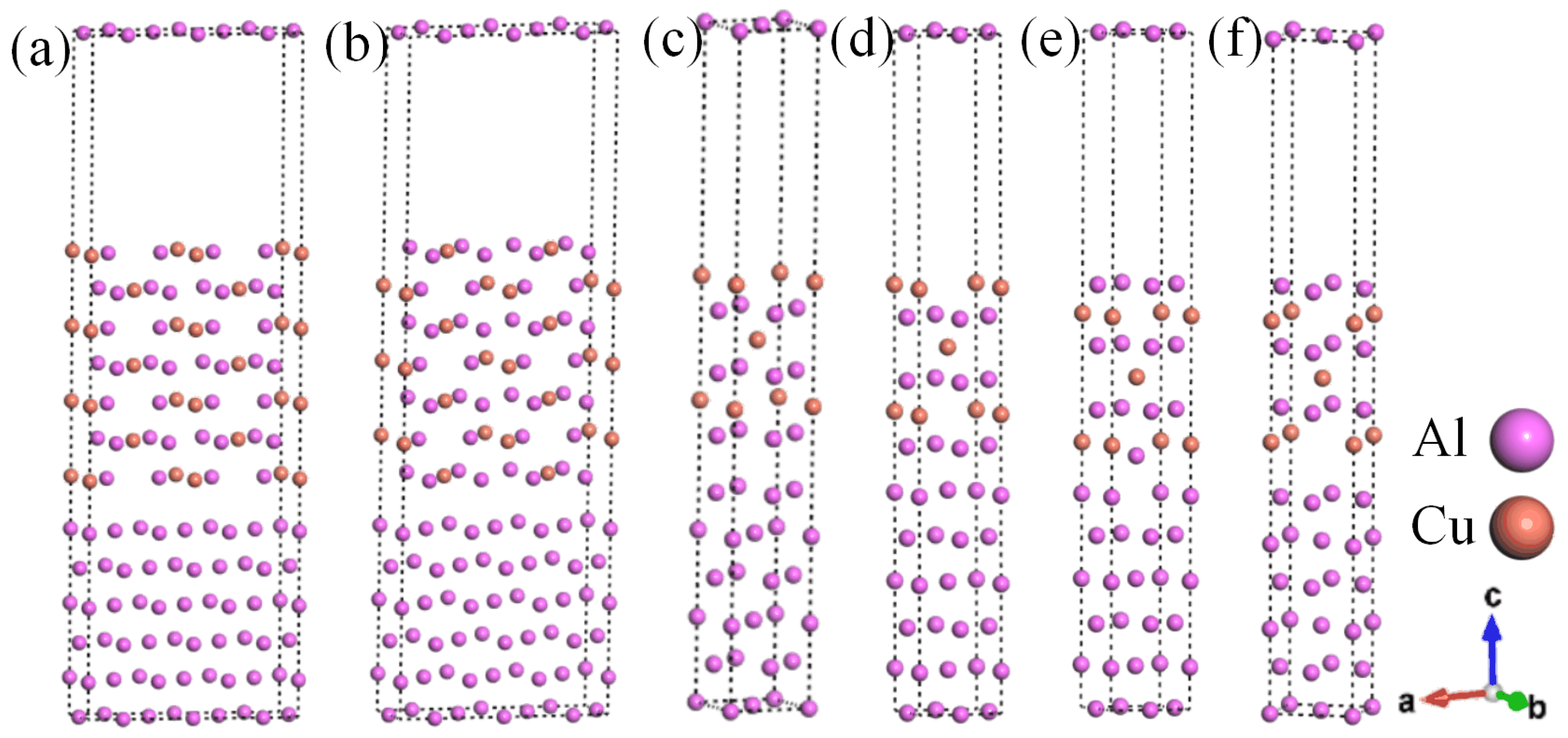

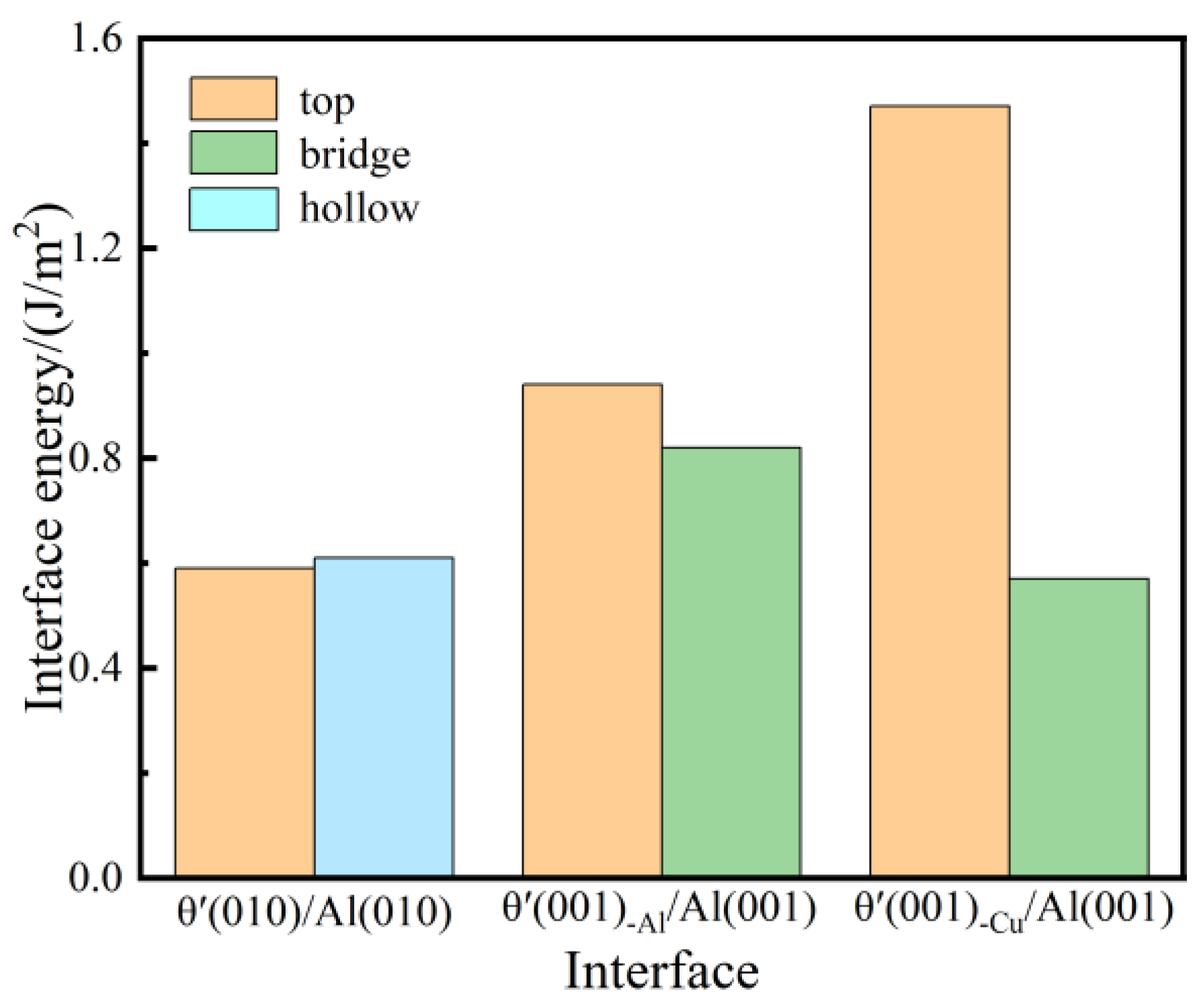

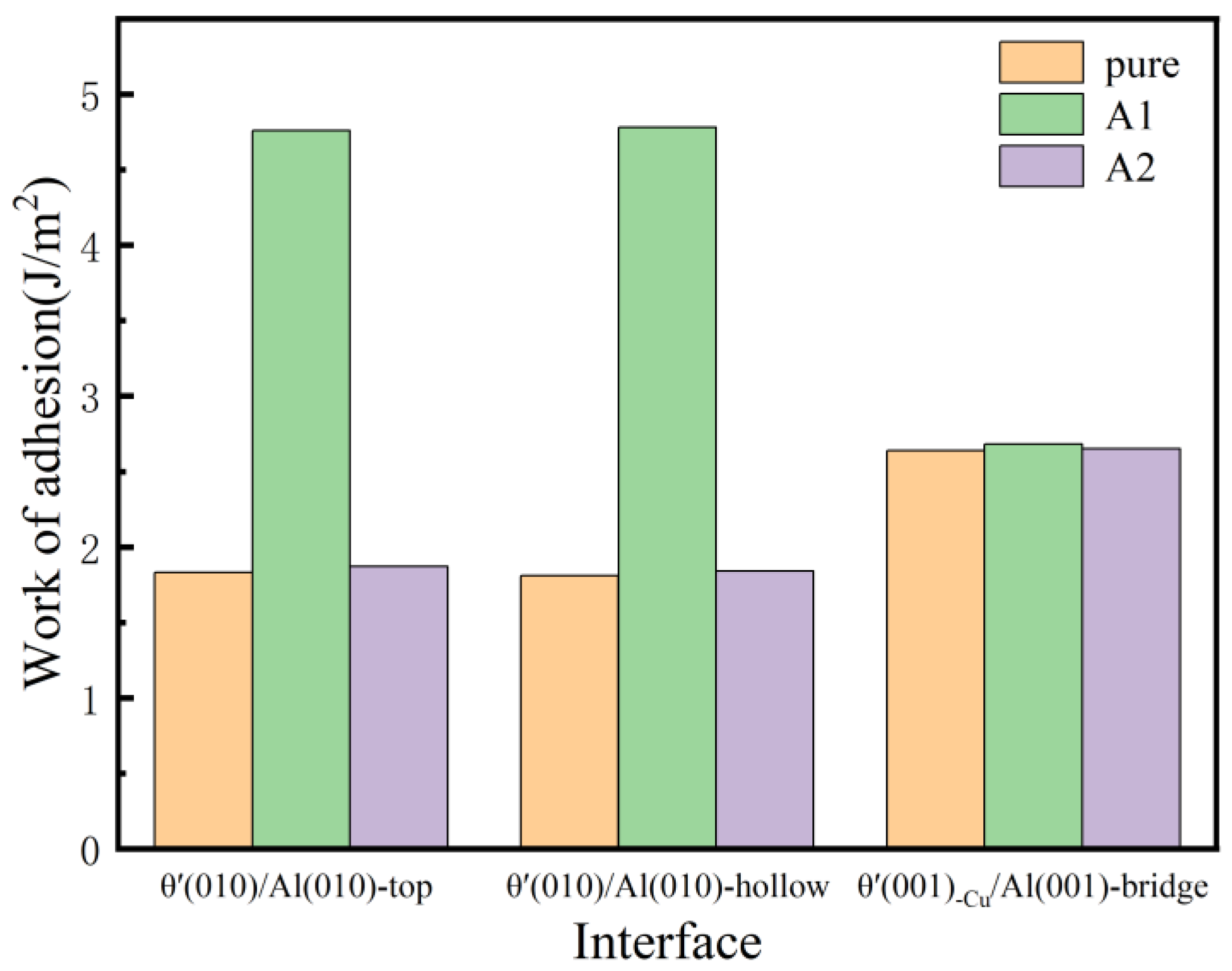
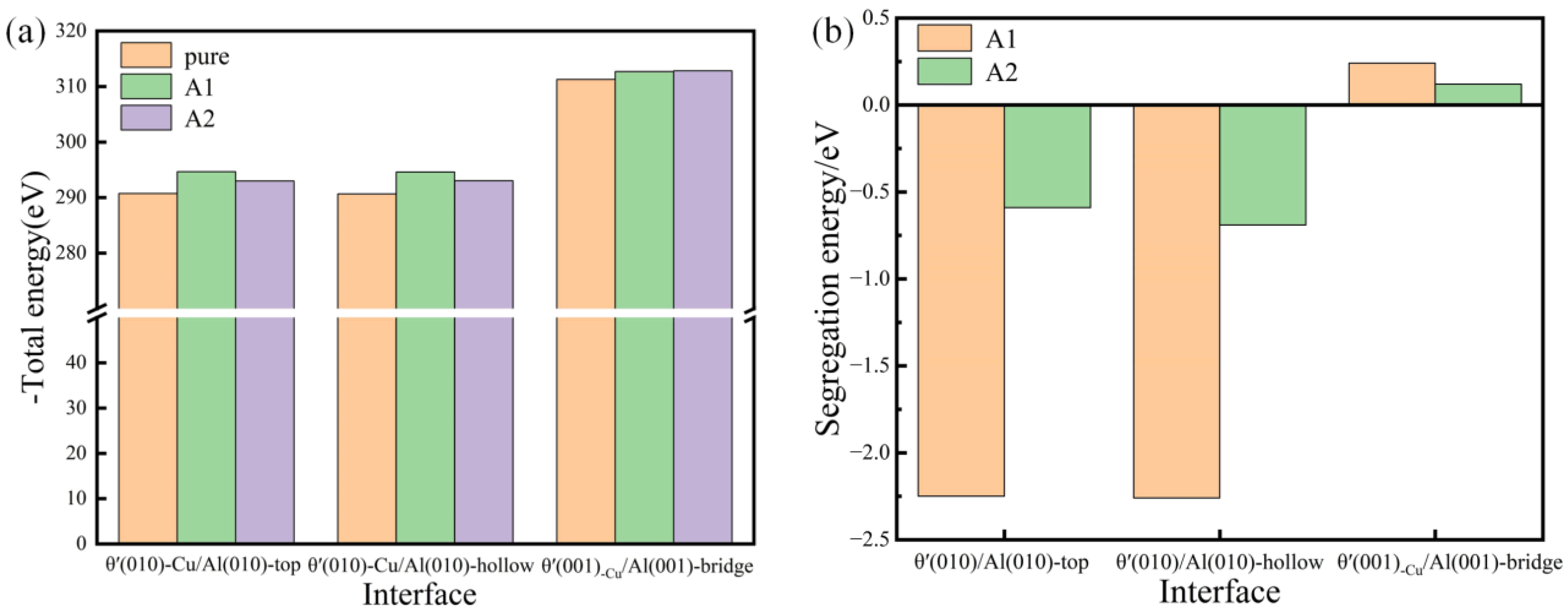

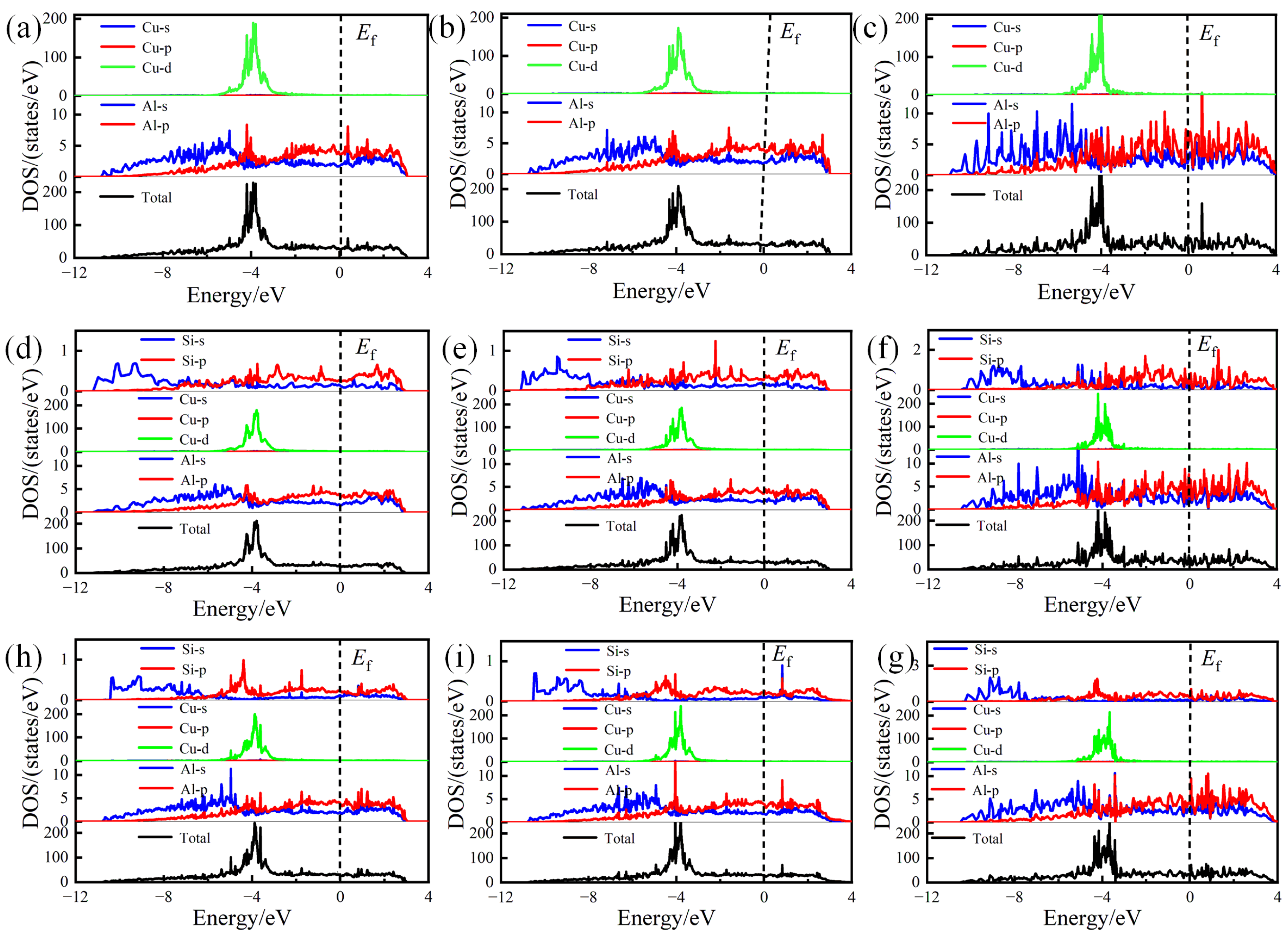
Disclaimer/Publisher’s Note: The statements, opinions and data contained in all publications are solely those of the individual author(s) and contributor(s) and not of MDPI and/or the editor(s). MDPI and/or the editor(s) disclaim responsibility for any injury to people or property resulting from any ideas, methods, instructions or products referred to in the content. |
© 2024 by the authors. Licensee MDPI, Basel, Switzerland. This article is an open access article distributed under the terms and conditions of the Creative Commons Attribution (CC BY) license (https://creativecommons.org/licenses/by/4.0/).
Share and Cite
Jiang, L.; Zhao, Z.; Wang, G. The Effects on Stability and Electronic Structure of Si-Segregated θ′/Al Interface Systems in Al-Cu Alloys. Coatings 2024, 14, 879. https://doi.org/10.3390/coatings14070879
Jiang L, Zhao Z, Wang G. The Effects on Stability and Electronic Structure of Si-Segregated θ′/Al Interface Systems in Al-Cu Alloys. Coatings. 2024; 14(7):879. https://doi.org/10.3390/coatings14070879
Chicago/Turabian StyleJiang, Lu, Zhihao Zhao, and Gaosong Wang. 2024. "The Effects on Stability and Electronic Structure of Si-Segregated θ′/Al Interface Systems in Al-Cu Alloys" Coatings 14, no. 7: 879. https://doi.org/10.3390/coatings14070879





